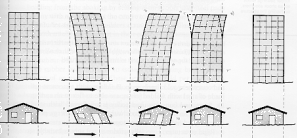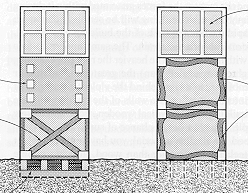

 |
 |
|
The number of deaths in an earthquake, and the amount of damage done does not simply depend on the size of the earthquake. Some of the highest death tolls have been recorded in countries where earthquakes are neither very large nor very frequent, and this is because deaths and damage largely depend on how well a country's buildings are constructed. Thus it is important to have both the knowledge and the money to make buildings strong enough to withstand nature's forces. Fur just such reasons it is often the poorer countries that suffer most, even if they are not particularly earthquake-prone. As shock waves from an earthquake pass through an area they don't simply strike a building, they generate forces within the building itself making it the cause of its own downfall. The ground can move in all directions in a very complex way: back and forth, side to side, and up and down, taking the building's foundations with it. |
The heavier the building the greater the forces generated within it during an earthquake. A very heavy inflexible building will be seriously damaged; its foundations moving rapidly while the bulk of the building lags behind, cracking as it fails to flex and absorb the strain. The same applies to top-heavy buildings or houses with heavy roofs. The heavier the roof, the greatest the tendence to stay put it has, so it lags behind the violent zigzagging of the foundations, placing intense stress on the walls of the building. See how the top of such buildings lag behind their foundations, which move with the ground. |

Movement of a house and a tall buidling in an earthquake. Notice how their top part lag behind their foundations. |

Modern eartquake-resistant structural desings make buildings either strong and sitff enough to carry the earthquake's force without cracking. |
Wood is a flexible material and steel, much stronger than wood, also has supple qualities. It can accept being deformed where brittle materials like brick and concrete would simply snap. Buildings with a moment-resisting frame, made of steel with welded joints, are able to flex in an earthquake. Structural concrete used todai is reinforced with steel to make it quake resistant. Steel rods within it absorb energy, provide tensional strength, and hold the concrete together. |
|
Having too much flexibility can also be a problem for buildings, since if they do not have sufficient rigidity the tops could snap off. A flexible-framed building can also cause great damage to its less flexible interior walls. Rigid structures, specially windows, are very vulnerable since they try to resist an earthquake's force completely, shattering in the process. Modern designs divide such rigid structures into pieces which can move separately form each other, like fish scales. Other strategies for survival are allowing structures to rock with the earthquake or isolating the buildings from the shaking by seating them on rubber and steel pads or bearings, many with a lead plug at the centre to act as an energy absorber. Many bridges are also built on rubber bearings which allow the bridge to move, to a certain extent, without structural damage. Earthquake engineering has come a long way in a short time. The
complex motions of earthquakes and their effects on buildings are
finally beginning to be undersood. Today, the behaviour of individula
structures can be tested using earthquake simulators - platforms set
vibrating on rubber bearings. Building design needs to take into
account the expected length of time the shaking may last, as the
longer the shaking, the greater the resulting damage. Buildings tend
to withstand high levels of shaking for a sort time (a second or two)
better than a moderate level of shaking for a longer period (tens of seconds).
Related links
|